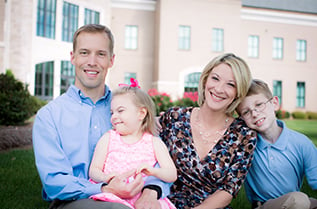Growing up in Greenwood, I always knew what was at the end of Liner Drive – the Children’s Clinic. It was where I would go see my pediatrician, Dr. Skinner for check-ups and illnesses. Fast forward ??? years later – you can do the math – I’m now working at the end Liner Drive, but this time it’s the Greenwood Genetic Center (GGC) on Gregor Mendel Circle at the end of that road.
So how did GGC evolve from a small building on Spring Street to a 50-acre campus with four buildings surrounded by another 140 acres?

The first GGC facility
Dr. Roger Stevenson & Dr. Hal Taylor were fellows together at Johns Hopkins University, where they dreamed of working in a patient-centered genetics program with state-of-the-art technology. When joining an established medical school didn’t pan out (remember this was in the infancy of medical genetics, it was not the big deal it is today), they took another route – establishing an independent center. In 1974, with support from Jim Self and the state of South Carolina, their dream was finally realized in the form of the Greenwood Genetic Center.
GGC started in a 7500 square foot building on Spring Street built to house clinic and office space, a chromosome lab, and even a library (this was before the internet, folks).
The Current Campus
The Center’s reputation grew, and as services expanded, the need for a larger, more specialized facility became apparent. In 1980, GGC relocated to its current site on Gregor Mendel Circle. GGC’s first building on the current campus housed the diagnostic labs. A few years later, in 1984, the clinic building joined the growing campus.
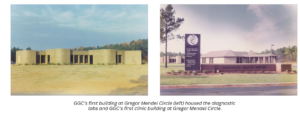
GGC’s growth didn’t stop there. Under the direction of Dr. Charles Schwartz, the Division of Research was formed in 1989. The diagnostic and research divisions shared laboratory space in the original lab building until 1996, when the JC Self Research Institute for Human Genetics building was completed.
The discoveries made in this building led to GGC’s international reputations in research on X-linked intellectual disability, birth defects, and other rare diseases. In addition to laboratory space for the research team, this building houses the Senator William O’Dell Boardroom, the Klauber Library, the Curry Conference Center, GGC Foundation offices, and the Hazel & Bill Allin Aquaculture Facility. The aquaculture facility came to GGC in 2018 with Drs. Richard Steet and Heather Flanagan-Steet when they joined GGC to lead research efforts following Dr. Schwartz’s retirement.
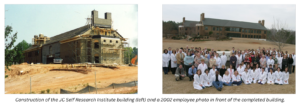
In 2009, GGC reached another milestone with the opening of the South Carolina Center Treatment of Genetic Disorders (the Treatment Center), a state-of-the-art facility dedicated to advancing the treatment for genetic disorders. When the Treatment Center (where I work) opened, the clinic and diagnostic labs moved in. The former lab building is still home to one of GGC’s lab – array, the rest of the building was converted to a Genetic Education Center for visiting students. The former clinic is now the dedicated home for our amazing administrative folks – billing, IT, HR, and finance.
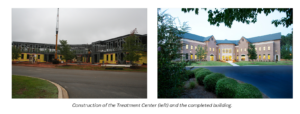
Our statewide presence
GGC is a statewide organization serving patient across all of South Carolina. In the early years, that meant our clinicians traveled to every county in the state to hold clinics. As our patient population grew, we needed a better way to reach those outside of the Greenwood area. In 1988, GGC opened two satellite clinic offices – one in Greenville and one in Columbia. A Florence office followed in 2004, and we expanded into Charleston in 2007. This made our clinic operations more efficient and significantly improved patient access for those all across the Palmetto State.
Beyond GGC
GGC’s campus and the surrounding 140 acres are a part of greater concept: the Greenwood Genetic Center Partnership Campus. With GGC being the anchor of the Partnership Campus, the campus offers location opportunities for bioscience companies and institutions that are committed to advancing scientific knowledge, promoting patient care, and collaborative initiatives. Clemson University took us up on that opportunity, and in 2018, the Clemson Center for Human Genetics (CHG) opened.
The Clemson CHG is led by world-renowned geneticist, Dr. Trudy Mackay. She leads a research team that focuses on genetic and environmental risk factors for a range of human diseases by using fruit flies as the model organism. The collaboration between GGC and Clemson CHG has led to funding from the NIH’s COBRE program (Center for Biomedical Research Excellence). Even this gamecock is proud to have Clemson on campus!
One advantage of working here is that we are able to enjoy the beautiful campus (fall is my favorite). Dr. Stevenson and Dr. Taylor started GGC with a vision; founding board member and long-time friend of the Center, Dr. Bill Klauber, believed in their vision. Upon Dr. Klauber’s passing, his estate provided funds to enhance the campus. In 2015, the Klauber Plaza was constructed in the center of campus to provide, “…beauty that would inspire vision for all those who saw it.”
Today, employees on the Greenwood campus enjoy the fountain and amazing sculptures when walking from building to building and the occasional picnic
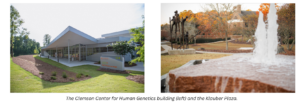
Post by Caroline Pinson
